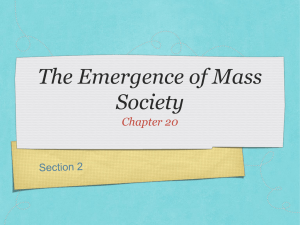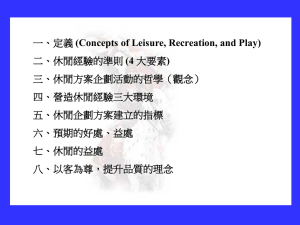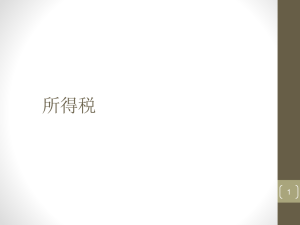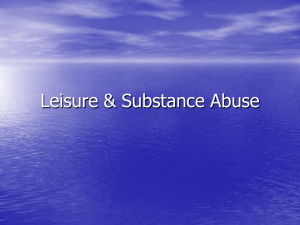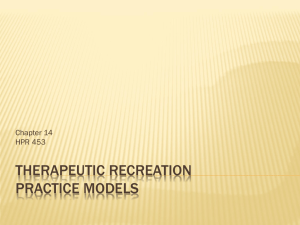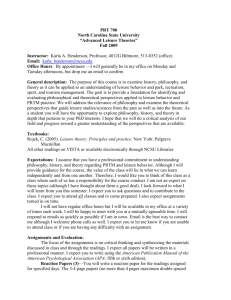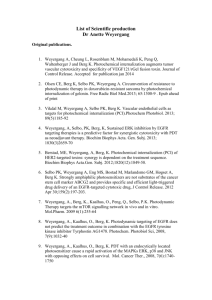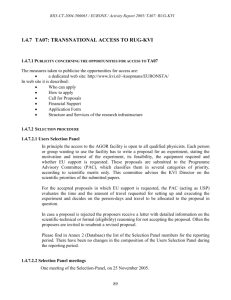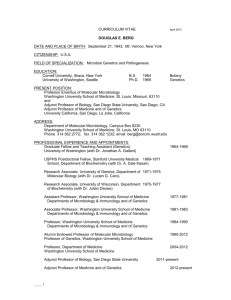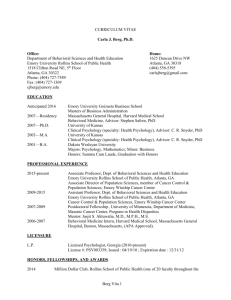the-informational
advertisement
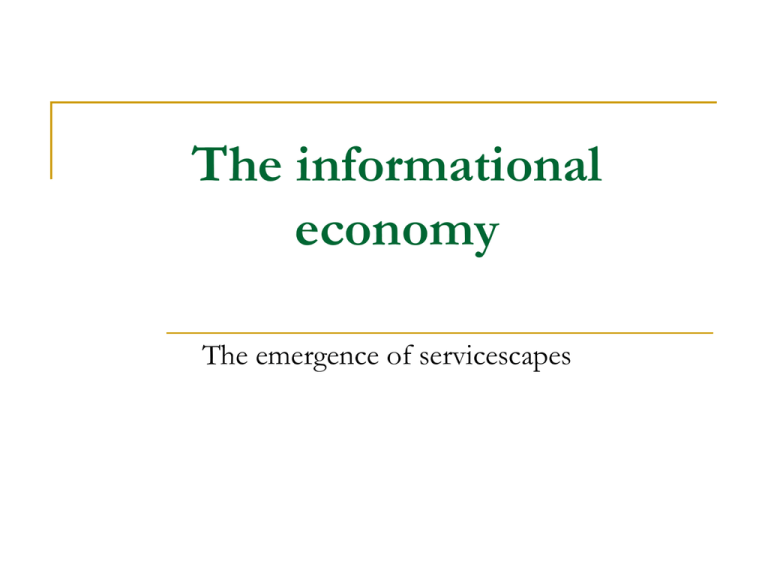
The informational economy The emergence of servicescapes Issues with information The University does not permit the use of file sharing or peer to peer networking software to be used within the University to share files out across the web (eg Kazaa) The University also does not permit extensive file downloading unless in support of Learning, Teaching or Research. The University does not permit the inappropriate and unauthorised sharing of copyright materials out across the Web. The University does not permit the storage of copyright materials such as MP3 files unless someone can prove that they have been authorised to use the materials and can prove that they are being used for learning, teaching or bona-fide research purposes. Any inappropriate usage which creates high bandwidth usage may result in Disciplinary action (see Regulations pertaining to the Use of University Equipment). It may also result in the UK educational network providers removing us form the Joint Academic Network (JANET). Therefore the consequences are extremely severe in terms of potential loss of credibility when a University attached to the academic network loses its connectivity publicly. Post-Industrialism Bell’s (1974) The Coming of the Post-Industrial Society popularised the notion of ‘post-industrialism’: Image of industrialism transformed by the new service sector professional trading in theoretical knowledge “Advanced” societies increasingly reliant on theoretical knowledge, replacing “capital and labour” An optimistic thesis, based on concepts of progress, but some: “reject the post-industrialist fantasy of technical sweetness and light” (Penley and Ross, 1991: pxiii) However, what is clear is that the so-called post-industrial period is signified by a different set of relationships with work and leisure: “The entire thrust of modern technology has been to move us away from solid objects and into informational space (or cyberspace). Man the farmer and man the industrial worker are quickly being replaced by man the information worker…we are less and less creatures of flesh, bone and blood; we are more and more creatures of bits and bytes moving around at the speed of light” (Terranova, 2000: 271) DEPENDENT ON AND CONSTRUCTED BY TECHNOLOGY Information Society (IS): “the modern story” Webster (2005) identifies five analyses of an information society: Technological innovation: Explosion of the use of IT heralds a new ‘silicon civilisation’ where we can all be linked together as computers facilitate a ‘network society’ (Castells, 1991) Information superhighway provides infrastructure for IS, replacing its industrial counterpart (e.g. roads, railways, canals) Technology the distinguishing feature of this ‘new order’ Facilitates ‘flexible specialisation’ (Piore and Sabel, 1984), allowing small firms to respond to emerging niche markets Remains a question mark over the ‘break from advanced industrialism’ and the inherent technological determinism of the information society thesis Information Society: “the modern story” Economic: Proponents produce evidence for an information or ‘knowledge’ economy (e.g. Scottish Executive priority area) Lash and Urry (1994) argue that knowledge workers require cultural services which can regenerate the declining industrial heritage Invention of circuits, microprocessors, and micro computers revolutionised capitalist organization; more flexible, speed and scope. Occupational: Evidence of IS when services become the dominant economic sector (e.g. from steelworker to entertainer) ‘Information literacy’ the new corporate buzzword Freeing workers from the chains of industrial work, and re-skilling them Critics identify McJobs and insecurity of service sector occupations, ‘servicing the wealth generators’ MANAGING INFORMATION CENTRAL TO THE TASK OF THE CULTURAL INTERMEDIARY Information Society: “the modern story” Spatial: Processing and distribution of information requires/reinforces need for interdependency, immediacy, interactivity, simulantaneity and speed (Virilio, 2000) Emphasises a shrinking world identifiable by a time/space compression (Harvey, 1992) Temporal and spatial boundaries de-stabilised, problematising ‘modern’ concepts e.g. nation-state, working day, workmates, holiday, sporting competition We are increasingly able to both work and ‘play’ with others in (previously) distant places 24/7 The ‘constraints of space’ (Webster, 2005) have largely been removed from both the production and consumption processes DOES THIS BREED ALIENATION AND INSTABILITY? Information Society: “the modern story” Cultural: Explosion in cultural information (e.g. books, videos, magazines, films, fanzines and associated distribution technologies (e.g. cinema, television, computers, MDs etc) (see Hesmondhaugh, 2002) Various technologies of photography allow us to ‘capture’ the most intimate and defining images of our lives: representing a slide-show of our very existence Technologies facilitate processes of signification, making the construction of a self-project more accessible (e.g. fashion, homemaking, lifestyle mgt) These, and other, technologies redefine our cultural landscape. Without them we would struggle to communicate and go about our daily lives Media technologies allow for the exchange and reception of messages informing, influencing (and inculcating?) our lifestyle choices WHAT USE IS INFORMATION WITHOUT A PROCESSOR TO INTERPRET ITS MEANING? Information Society: Key questions Accounts of IS assume the benefits of technology will be distributed in a roughly equitable manner, but what about the role of IT in control and surveillance of our consumption and lifestyle? Information age premised on the belief in ‘progress’: improvements and development are assumed, but for whom? What about the status of ‘information’ (FOI) The explosion of signs and information leads to a collapse of meaning (Baudrillard, 1993) and depthlessness. Are notions of ‘truth’ and the ‘real’ increasingly challenged by the ‘death of the author’ (Foucault)? Are we concerned as traditional notions of community, workplace, family and leisure are swept away? The end of progress: the postmodern story (Rojek, 1995) Social condition or social consciousness? Associated with instability, mobility, constant flux and fragmentation Celebrates a playfulness and theatre of experiences, like Debord’s (1967) ‘society of the spectacle’. ICT’s facilitate the spectacular and the superficiality of everyday life Communication and information exchange central to postmodernity. Electronic images become the sole means of communication (think ‘aestheticization’) Previous industrial work spaces now become leisure spaces (e.g. textile mills and coal mines); loss of meaning? ‘Cyberspace’ the ultimate postmodern metaphor as it is detached from a geographical reality and solidity But what are the social and psychological impacts of this leisure environment? Indicative References Bell, D (1973) The Coming of Post-Industrial Society, Penguin Webster, F (2005) Theories of the Information Society, Routledge Kumar, K (1995) From postindustrial to post-modern society: new theories of the contemporary world, Blackwell Lash, S & Urry, J (1994) Economies of Signs and Space, Sage Rojek, C (1995) Decentring leisure, Sage (Chapter’s 7 & 8) Cooper, J & Harrison, D.M. (2001) 'The social organization of audio piracy on the Internet', Media, Culture & Society, 23 (1): 71-89 Danet, B (2001) Cyberpl@y: Communicating Online, Berg Bull, M (2003) The Auditory Culture Reader, Berg Hadden, L (2004) Information and Communication Technologies in Everyday Life: A Concise Introduction and Research Guide, Berg

